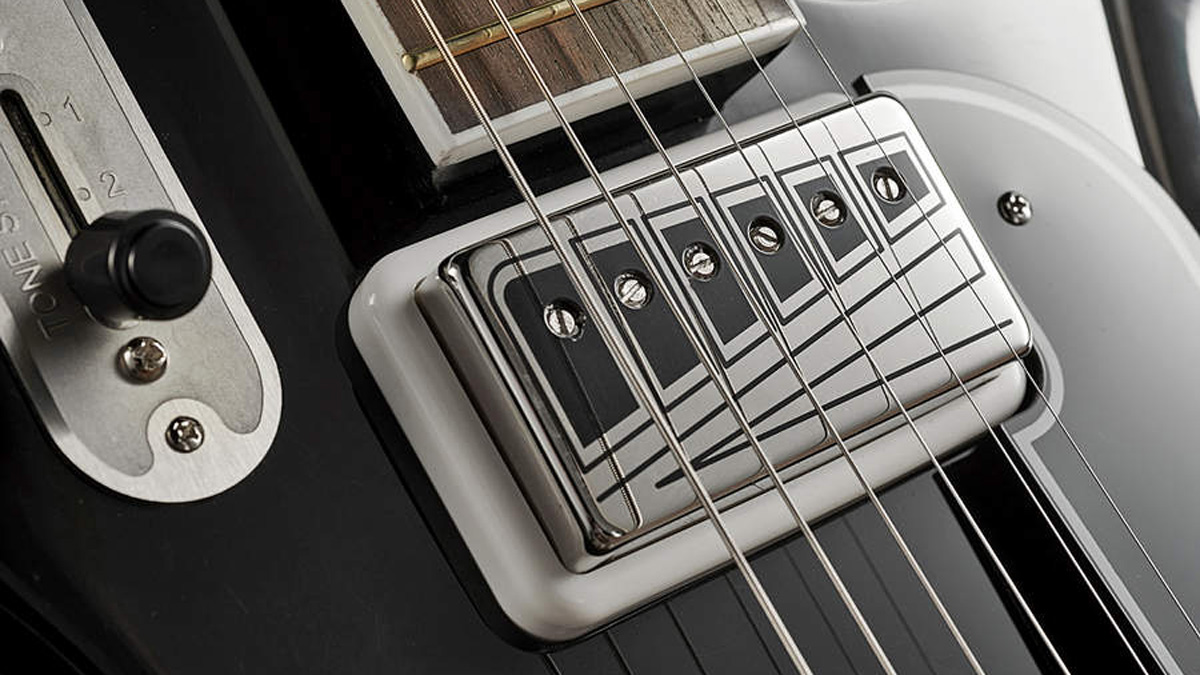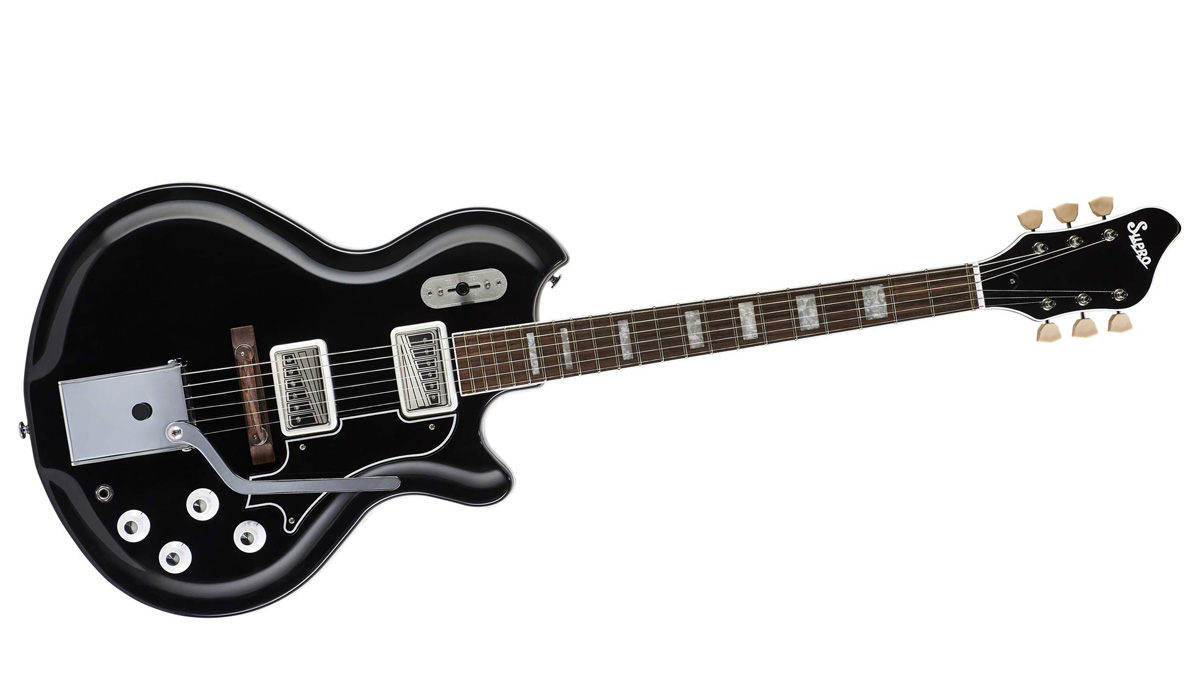MusicRadar Verdict
A real grower.
Pros
- +
Competent reissue of classic Res-O-Glas style with new-design vibrato and time reveal sounds to match the vibe.
Cons
- -
Limited colours, bridge and intonation, no gigbag.
MusicRadar's got your back
Having relaunched the amps, two new ranges of Supro guitars were finally unveiled at the start of 2017 - the solidbody Island Series and the Americana Series, which centre on the classic and most collectable - if originally short-lived - Res-O-Glas-bodied Valco creations that appeared under various names including National and Supro.
Irrelevant of heritage, this new incarnation offers considerable time-travel appeal. With chrome aplenty and high-gloss finish, thankfully it avoids the once fashionably bonkers control systems. Our Supro follows Gibson protocol with dual humbucker-sized single coils, a three-way toggle pickup selector and volume and tone for each pickup.
Build
As one of the four original Supro guitars we looked recently, the Coronado II was very nearly a favourite except the vibrato version wasn’t yet available. Now it is.
It’s the larger of the two body sizes offered by Supro in the American Series - 381mm (15 inches) wide x 483mm (19 inches) long . This is as opposed to the smaller size of the Dual Tone, for example, which is more Les Paul-like at 343mm (13.5in) wide x 457mm (18in) long.
It’s a two-piece sandwich construction with the back half mahogany routed out to leave an ES-335-like centre section. The top half is moulded ‘Acousti- glass’ (an ABS high-impact plastic) with added centre block. The two pieces of the sandwich are screwed together from the back and the edges are joined with a white rubber gasket.
As we originally observed, if you want to access the internal electronics there’s no control cavity backplate - you literally have to disassemble the body (easy enough although getting the halves back together isn’t as swift).
From our previous investigation these new Supros use 1meg pots and vintage-style wiring. Aside from that there are no tricks and the shoulder placed three-way lever pickup switch (aka Tone Switch) sits in a nicely-detailed mounting ring with quaint 1 (neck), 2 (both) and 3 (bridge) positions.
Want all the hottest music and gear news, reviews, deals, features and more, direct to your inbox? Sign up here.
The quirks continue with an old-style archtop-like, two-piece height-adjustable but pre-compensated wooden bridge. Two fixing screws sit under the top half so you can secure it but it’s quite a faff to achieve. The humbucker-looking pickups with their Art Deco-style decoration are actually single coils despite high dc readings of 8.17 (neck) and 9.2kohms (bridge), a result of smaller gauge wire.

Now called Vista Tones, they replicate Ralph Keller’s original Supro design including height adjustment via the outer two polepieces. They also sit on the face of the body, they’re not recessed, so the strings themselves really sit some distance from the body face.
Likewise, the maple neck, fixed to the body with two cross- head bolts it sits in a shallow rectangular slot in the top’s centre block. It’s all a bit creaky ship but seems to work. Further original details are the large headstock with its raised plastic Supro logo and those vintage-y three-on-a-strip style tuners with over-large cream plastic ‘butterfly’ buttons.
And instead of the ‘stairstep’ tailpiece of the non-vibrato model, here we get a large rectangular metal box vibrato bolted to the body with a black-knobbed screw that holds the top in place and a protruding, long, vibrato arm. There’s little doubt it adds to the overall weight (and balance) - our non- vibrato model weighed in at 3.45kg, this one is 3.77kg.
Removing the top-plate you can easily see the two tension springs (attached to a Strat-like spring claw). At the front of the unit is the bar into which the strings are anchored. There are no Bigsby-like pins, the strings pass through the bar and over the top and onto the bridge giving, bearing in mind the height of the bridge, very little back angle. We have to say it’s not the easiest to re-string as you have to thread the G and D under the spring retainer bar and, of course, remove and refix that top-plate.
Sounds
This guitar does not place ergonomics at the forefront. This Supro might hail from the early 60s, but it feels more akin to a jazz-box from the previous decade that’s been given a contemporary (as in the 60s) makeover. It sounds a little antiquated - there’s a bit of semi-bloom and an acoustic volume but with a shorter, plunkier response.
In terms of set-up, the Supro needed a truss-rod tweak (there’s more relief on the bass side than the treble) and a bit of manual movement to get the intonation, sort of, right. If you’re particular about set-up, it’s not for you.
The Supro goes for a skinny depth neck - 20.5mm at the 1st, 22mm at the 12th - although the shape is similarly a relaxed C with slightly narrower and lower frets (2.4mm wide x 0.9mm high) and slightly smoother fingerboard edges, which of course are bound.
The Supro really doesn’t do conventional. The combination of its idiosyncratic construction and feel might have you putting it back on the store wall. Our advice is to persevere. There’s a throaty bite at bridge, a real older blues voice that snaps and snarls - more Tom Waits than Tom Petty. That said, and as we concluded previously, it does a great late-60s Stones or Kinks.
It’s little surprise that kicking in a Supro Drive pedal is a perfect match heading us Detroit way. Kick in a fuzz and take a waggle on the smooth-feeling vibrato and sonic chaos ensues. Tuning stability? It needs a little sorting, the bridge rocks and the break points on the rosewood bridge are a little vague. But the slightly ‘out’ intonation almost adds to its authenticity. Not for everyone, but there’s a wealth of old-school tones here for the 50s or 60s revivalist or anyone that wants to explore different sonic paths. A grower.
Supro’s convoluted and complex build marries archtop ‘jazz age’ style with an Art Deco-inspired aesthetic and is harder to pigeonhole. It remains quite a unique characterful drive but one that we suspect will be more polarising. Get to know it, however, and it’s a wonderfully unpredictable and creative tool to summon up some older, funkier, tones.
Dave Burrluck is one of the world’s most experienced guitar journalists, who started writing back in the '80s for International Musician and Recording World, co-founded The Guitar Magazine and has been the Gear Reviews Editor of Guitarist magazine for the past two decades. Along the way, Dave has been the sole author of The PRS Guitar Book and The Player's Guide to Guitar Maintenance as well as contributing to numerous other books on the electric guitar. Dave is an active gigging and recording musician and still finds time to make, repair and mod guitars, not least for Guitarist’s The Mod Squad.

